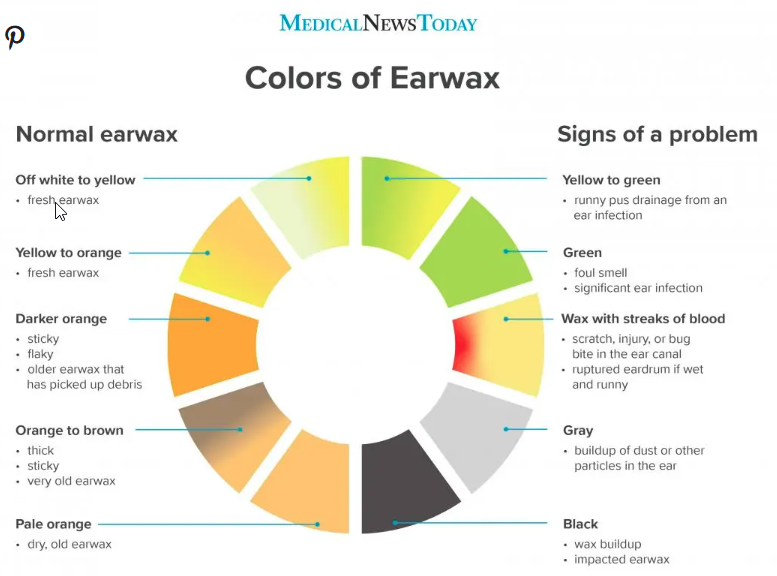STORY UPDATED: check for updates below.

Does the color of your earwax reveal the "true state" of your health, with white earwax indicating a vitamin deficiency and black earwax suggesting a fungal infection? No, that's not true: Earwax can come in a range of colors from dark to light, but it doesn't reliably show if you're healthy or have problems like infections. If it changes a lot in color, texture or smell, it could mean an issue, but typically it's not enough to diagnose anything.
The claim appeared in a post (archived here) on Facebook on November 22, 2024, under the on-screen title "Our ears reveal our true state of health ✋✋" The post's caption said:
Good to know. Details in the first comment 👇
This is what the post looked like on Facebook at the time of writing:
(Source: Facebook screenshot taken on Mon Nov 25 17:23:02 2024 UTC)
The post provided no evidence to support its assertions.
The first comment in the post includes a link (archived here) to a website with the same title same as the post's on-screen title: "Our ears reveal our true state of health." It said:
Earwax, or cerumen, is crucial for ear health, protecting against dirt and bacteria. Its color and texture can signal health issues: Gray: Often from pollution, no worries unless irritation occurs.Blood: Indicates injury or a perforated eardrum, see a doctor.Dark Brown: May result from stress, relax to reduce it.Black: Could suggest a fungal infection, seek treatment.White: Might indicate vitamin deficiencies, improve diet.
Strong Smell: Possible middle ear infection, get checked Liquid: Signals infection, see a doctor.
Dry: Linked to dehydration or low-at diets, stay hydrated and eat healthy.To keep ears healthy, avoid overcleaning, stay hydrated, protect from noise, and consult a doctor for persistent changes or discomfort.
Neither the social media post nor the information in the website is attributed to any medical source or expert.
Experts
Dr. Elliott Kozin, an otolaryngologist or ear, nose and throat (ENT) specialist at Mass Eye and Ear Hospital in Boston, told Lead Stories in an email on November 25, 2024, "There is no correlation of cerumen (earwax) color and health." He continued:
- Cerumen is a natural part of the ear canal to help moisten the canal and decrease infections.
- If wax is red colored and appears like blood, this may indicate an underlying issue that should be discussed with a medical provider.
- Ear symptoms that should prompt medical evaluation include pain, hearing loss, dizziness, and persistent drainage from the ear.
In a November 26, 2024, email to Lead Stories, Dr. Kaicheng L. Yen, an ENT specialist at UC Davis Health in Sacramento, California, said, "The color of cerumen is a poor indicator." He added:
Generally speaking, light colored cerumen are usually newly formed, and if left in the canal for a long time, it turns to a darker brown color, almost black at times. This is because the cerumen oxidizes, very much like an apple turns brown if left in the air for long periods. ...
The nature of the cerumen are generally genetically determined, such as the amount of oil content, which will affect the shade of color.
Cleveland Clinic
The Cleveland Clinic website (archived here) echoes Kozin and Yen, saying color has little to do with the "true state" of your health. The hospital's page on "Earwax" doesn't make the same correlation between colors and conditions or ailments that the unattributed social media post does:
What color is earwax?
Healthy earwax ranges in color and may be:
- Off-white.
- Yellow.
- Orange.
- Light brown.
- Dark brown.
However, you should call a healthcare provider if you have earwax that's:
- Green. This could mean you have an ear infection.
- Black. This is often seen in people with impacted earwax (earwax blockage).
- Brown with red streaks. This may indicate an injury inside your ear canal. If the discharge is runny, it might mean you have a ruptured eardrum.
The hospital's page says the earwax information on its website was "medically reviewed."
Medical News Today
The Medical News Today website (archived here) has a graphic that illustrates the same information, sharing healthy earwax color ranges on the left and the unhealthy on the right. Again, this information doesn't match the conclusions shared in the social media post:
(Source: Medical News Today screenshot taken on Mon Nov 25 22:37:09 2024 UTC)
Other Lead Stories fact checks of claims concerning earwax are here.
Updates:
-
2024-11-26T16:25:26Z 2024-11-26T16:25:26Z Adds context from Dr. Kaicheng L. Yen, an ENT specialist at UC Davis Health.



















